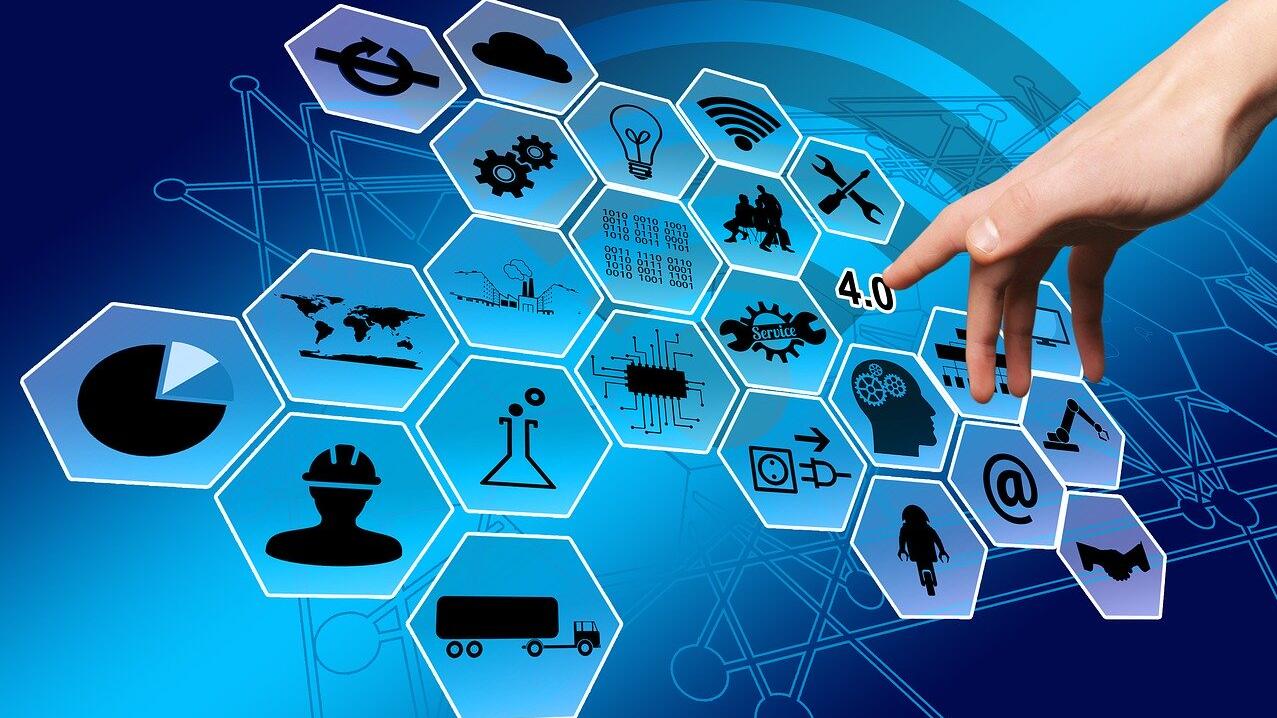 Digitalisation
DigitalisationIndustry digitalisation from an energy perspective
Summary
Digitalisation offers opportunities for high-skilled employment and innovation, integration of renewable energy, and cuts in operating costs. Digital twins and data analytics continuously optimise manufacturing processes for efficiency and safety, identify savings opportunities, and enable predictive maintenance. The number of connected devices worldwide is projected to grow from 15 billion in 2015 to 75 billion in 2025 (Statista in IRENA, 2019)
Digital technologies facilitate other energy efficiency measures, and in turn become even more beneficial once energy efficiency has been improved. There is significant evidence that energy efficiency gains from the application of advanced digital process controls can yield significant savings at little or no
no net cost (IEA, 2017)
The shift towards smart products and services (automation) is estimated to result in additional energy savings in 2050 of 5% in an "Efficient" scenario and -11% (i.e. Digitalisation in industry can also help maintain grid stability and reliability (ieA,IEA).
Open full article
Industry digitalisation from an energy perspective
The digital revolution - 2 page factsheet by the Joint Research Center
The digital revolution
Digitalisation is the innovative use of information and communications technologies, in particular the large-scale rollout of smart devices and sensors, often involving big data collection and analysis. These and other relevant technologies (such as online platforms, cloud computing, the industrial Internet of Things, digital twins, 3D printing, robots, Artificial Intelligence, and blockchain) are elements of advanced manufacturing, or integrated intelligent manufacturing – the fourth industrial revolution.
Digitalisation offers opportunities for high-skilled employment and innovation, integration of renewable energy, and cuts in operating costs. It optimises industrial operations and planning, connects energy producers and users, and facilitates new business models based on the circular economy, sharing and leasing.
In this way, digitalisation contributes to changes in energy market design, drives the development of smart cities, factories, communities and buildings, and makes district heating and cooling cheaper and more efficient. Across the economy, strategies are shifting from using digitalisation simply to cut costs and boost production, towards the development of revenue streams from new services and customisation.
Beneficial digitalisation
Digitalisation increases efficiency in all industry sectors, including energy-intensive ones, and at every step of product and process design and production:
- Almost everything is designed with computer software, from buildings to mobile phones to packaging. Using digital technologies to design products for re-purpose, sharing, reuse and recycling can become the default.
- Artificial Intelligence and smart controls can increase the pace and autonomy of experimentation, making research and development cheaper and reducing the large amount of energy used for ventilation.
- Digital twins and data analytics continuously optimise manufacturing processes for efficiency and safety, identify savings opportunities, and enable predictive maintenance.
- Benefits of robots (especially in car and electronics manufacturing) and 3D printing (in aerospace, medical equipment and transport) include improved accuracy and reduced waste.
- The Internet of Things allows greater traceability of materials and products (including at end of life), and increases utilisation rates of consumer goods, vehicles and physical infrastructure. The number of connected devices worldwide is projected to grow from 15 billion in 2015 to 75 billion in 2025 (Statista in IRENA, 2019).
- Blockchain can be used to lower operational costs; enhance the safety or efficiency of transactions; prove ownership; origin or authenticity; avoid fraud and counterfeiting; or automatically execute contracts. Challenges include integration with other digital technologies, the cost of migration and interoperability.
- Digital technologies improve delivery by optimising shipments, routes and traffic systems. There is also potential for distributed manufacturing to reduce distances along product supply chains.
Digital technologies and the new services they enable require energy to operate. And insofar as digitalisation improves the efficiency of energy use, it may also encourage industry to use more of it. In aggregate, there is significant evidence that energy efficiency gains from the application of advanced digital process controls can yield significant savings at little or no net cost (IEA, 2017). However, given the uncertainty in the potential net effect, foresight approaches are appropriate. Economy-wide, the shift towards smart products and services (automation) is estimated to result in additional energy savings in 2050 of 5% in an "Efficient" scenario and -11% (i.e. lost energy savings) in an "Inefficient" scenario (Fraunhofer ISI, 2019).
Potential savings vary according to the type of activity, management systems, culture and degree of supply-chain integration. Many industrial facilities will be able to identify alternative investments that can save more energy than digitalisation, taken in isolation. However, there are important synergies to bear in mind: digital technologies facilitate other energy efficiency measures, and in turn become even more beneficial once energy efficiency has been improved. A range of other benefits should also be taken into account, such as reduced (and less volatile) operating costs, less downtime, and better product quality.
As an example, wind turbine assembly can be optimised using data traceability. Based on established processes from truck manufacturing, SiemensGamesa Renewable Energy has implemented a just-in-sequence system to minimise production failures, and remotely controlled self-propelled modular transporters to move completed parts from the assembly line onto specialised roll-on/roll-off vessels.
Digitalisation in industry can also help maintain grid stability and reliability. Using the Internet of Things to connect, aggregate and control loads can allow industry to participate in frequency regulation markets and provide balancing services to the grid. Demand response is already in place in Finland, France and elsewhere. In time, this should spur the development of smart energy systems that connect industry clusters with power generation, residential buildings and district heating and cooling.
Another important benefit is that digitalisation promotes electrification of processes, and therefore the integration of greater shares of renewables. Broader societal benefits such as improved air quality should also be taken into account.
What needs to be done?
The principle of “energy efficiency first” should be applied at all stages of design and deployment – and any emerging rebound effects should be carefully monitored. On that basis, policies should encourage broad adoption of digital technologies and enable participation in demand response.
The level of digitalisation and the uptake of technologies varies considerably by Member State, by region and by company size. Public investment may be necessary to address this, as well as the extension of high-capacity fixed and mobile broadband to less populated and remote regions.
Although Europe is in a good position in terms of research quality and number of start-ups, it lags behind Japan, Korea and the United States in the number of Artificial Intelligence patents filed or granted each year (OECD in González Vázquez, 2019). In addition, digital technologies for industrial processes must be absolutely reliable and this demands highly qualified software engineers and extensive testing. Research and development funding should be ramped up, including for new business models, and standardisation and interoperability activities should be intensified.
Digitalisation delivers economic benefits through greater productivity and new jobs in advanced manufacturing and support services. However, its deployment requires careful consideration of the impact on existing jobs, in particular those involving predictable, routine and repetitive physical tasks. About 15% of employment in the EU is in industry, a share that remained stable between 2016 and 2018 (Eurostat, 2019).
While digitalisation affects the overall structure of employment, many other factors, including urbanisation, deindustrialisation and labour-market institutions, are also at play. To date, the net effect of technological change on employment appears to be neutral or even positive, once adjustment processes between firms and sectors have been taken into account (González Vázquez, 2019). However, it is possible that digitalisation is different, and whatever the net effect it will affect millions of jobs, so continued technology monitoring and foresight would be prudent.
What is already being done?
The Clean Energy for All Europeans package and the revised Energy Performance of Buildings Directive contained important steps in the right direction, with digitalisation now playing a prominent role in electricity market design and the decarbonisation of buildings. The European Green Deal is giving this work new impetus, with the twin climate and digital transitions at its heart.
Europe has already invested one billion euro in largescale pilots of digital industry platforms via Horizon 2020, increasing co-operation across value chains and Member States. Key funding opportunities in the next Multiannual Financial Framework are the InvestEU Programme, Horizon Europe, Digital Europe, the Connecting Europe Facility and the Structural and Investment Funds.
An example of an initiative in this area is the Smart Specialisation Platform for industrial modernisation, which combines smart specialisation and inter-regional cooperation to boost industrial competitiveness and innovation. All EU regions with their clusters and industrial partners are encouraged to take part and a partnership in a new thematic area can be proposed by any EU region or group of regions. Digital Innovation Hubs act as a one-stop shop by offering businesses access to knowledge, methods and software, technology platforms and testing facilities.
On the regulatory side, an example is the European Committee for Standardization-European Committee for Electrotechnical Standardization (CEN-CENELEC), which has been developing standards for electricity and telecommunications networks, energy management systems, data formats for electronic invoicing and digital skills.
Conclusion
The European industry is embarking on twin climate and digital transitions, and there are important synergies between the two, in particular the potential for energy savings and decarbonisation. Digitalisation also has the potential to disrupt the job market and employment patterns. However, new policies based on a holistic understanding of the energy and digital sectors would mitigate those side-effects and maximise the benefits.
Feedback and suggestions are welcome and can be sent to Lorcan Lyons: lorcan.lyons(at)ec.europa.eu.



